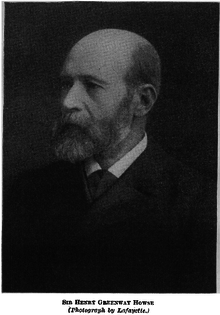Henry Howse
Sir Henry Greenway Howse FRCS (21 December 1841 – 15 September 1914)[1] was an English surgeon, sometime President of the Royal College of Surgeons.[2]
Sir Henry Greenway Howse | |
|---|---|
 Sir Henry Greenway Howse[1] | |
| Born | 21 December 1841 Bath, England |
| Died | 15 September 1914, aged 72 Sevenoaks, UK |
| Nationality | British |
| Education | Guy's |
| Occupation | Surgeon |
| Known for | Antiseptic orthopaedic surgery |
| Medical career | |
| Profession | General Surgeon |
| Institutions | London University, Guy's |
| Awards | Hunterian Oration, Knighthood, Bradshaw Lecture |
Life
Henry Greenway Howse was born in Lyncombe Hall,[3] Bath (England) to Henry Edward Howse and Isabella Howse (née Weald).[4] He entered an apprenticeship in Reading at age 18 before commencing training at Guy's Hospital at age 20.[1]
He had subsequent appointments at London University as a demonstrator in anatomy, before returning to Guy's as a member of staff as a surgery lecturer.
In 1881 he married a Miss Marshall, daughter of Thomas Lethbridge Marshall (a Unitarian minister at the New Gravel Pit Chapel); they subsequently had three daughters and one son.
His contributions include the development of new methods for preserving anatomical specimens for teaching (using a mixture of glycerine and arsenic), introducing histology (rather than just gross anatomy) as a part of the training for surgeons, propagating the antiseptic methods of Lister and knee surgery, although his surgical practice was very broad. He wasn't a prolific author, but did write entries for Heath's Dictionary of Practical Surgery[5] and as an Editor for Guy's Hospital Reports.[1]
For the Royal College of Surgeons he was Vice-president (1897-1900) then President (1901–1903). He was knighted in the 1902 Coronation Honours list,[6] receiving the accolade from King Edward VII at Buckingham Palace on 24 October that year.[7]
Honours
- Bradshaw Lecture — 1899[8]
- Knighthood — 1902[8]
- Hunterian Oration — 1903[8]
References
- "SIR HENRY GREENWAY HOWSE, M.S., F.R.C.S.: Consulting Surgeon to Guy's Hospital". British Medical Journal. 2 (2804): 560–563. 1914. doi:10.1136/bmj.2.2804.560. PMC 2299814.
- "Plarr's Lives of the Fellows Online". Royal College of Surgeons. Retrieved 16 August 2015.
- "Lyncombe Hall, Bath". British Listed Buildings. Retrieved 16 August 2015.
- "Sir Henry Greenway Howse". Howes Family Genealogy Pages. Retrieved 16 August 2015.
- Heath, Christopher (1886). Dictionary of practical surgery: Volumes 1 and 2. London: Smith, Elder & Co. pp. 970& 884.
- "The Coronation Honours". The Times (36804). London. 26 June 1902. p. 5.
- "No. 27494". The London Gazette. 11 November 1902. p. 7165.
- Welch, Charles, ed. (1905). London at the Opening of the Twentieth Century. Brighton: W. T. Pike & Co. p. 192.